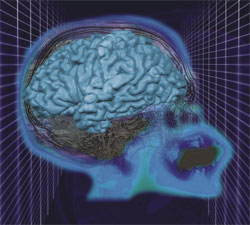|
by Michael CHEE

 ntil fairly recently, understanding the mind involved formulating theories and conducting experiments using behavioural endpoints. Psychologists researching behaviour sought to predict it without necessarily achieving insight into how the brain creates that behaviour — a so-called black box approach. The availability of new tools enabling us to study the brain from the molecular to the whole-system level has led to appreciation of the fact that knowing how the brain operates leads to more complete understanding of behaviour. Such understanding also provides a clear basis for developing non-behavioural therapies for people affected by learning disorders, neurological conditions, or mental illnesses. ntil fairly recently, understanding the mind involved formulating theories and conducting experiments using behavioural endpoints. Psychologists researching behaviour sought to predict it without necessarily achieving insight into how the brain creates that behaviour — a so-called black box approach. The availability of new tools enabling us to study the brain from the molecular to the whole-system level has led to appreciation of the fact that knowing how the brain operates leads to more complete understanding of behaviour. Such understanding also provides a clear basis for developing non-behavioural therapies for people affected by learning disorders, neurological conditions, or mental illnesses.
This issue of INNOVATION presents articles that illustrate the diversity involved in exploring the brain in health and in mental illness. Two leading scientists from the United Kingdom share their views on where advances in neuroscience are taking us. Colin Blakemore, whose research lies in the realm of vision science and early brain development, gives his perspective on what is in store in brain-function investigation from a systems level. Nancy Rothwell touches on the benefits accrued from understanding inflammation within the central nervous system.
Until recently, relatively few scientists have been afforded the opportunity to study the link between brain and behaviour. A summary of the tools of the trade and their function sets the background for ways in which researchers and professionals conduct examinations of the brain.
The availability of brain imaging — first, positron-emission tomography, or PET, and subsequently, functional magnetic resonance imaging, or fMRI — has truly revolutionised study of the connections between mind and behaviour. Researchers can now explore relationships as varied as arithmetical reasoning (Vinod Venkatraman), memory during sleep deprivation (Wei-Chieh Choo), economic value judgment (Soo-Hong Chew), and memory and executive-function deficiency in schizophrenia (Hao-Yang Tan).
Brain scanning permits evaluation of the congruence between what a subject reports perceiving and what the brain actually processed. In some cases, subjects remain unaware that their brains have registered information. At other times, incongruity could signify a deliberate attempt to mislead. This technology might have application in understanding consumer preferences, uncovering covert personality traits, and enhancing lie detection.
Perhaps more urgently, those physically unable to move or to speak despite intact brains need a means to communicate — one of the more helpful applications of brain–machine interfaces tapping electrical brain signals (Gerwin Schalk and Cuntai Guan), interpreting them and translating will into purposeful action.
On the flip side, military applications taking the form of thought-controlled weapons systems could also emerge. Indeed such systems, combined with synthetic cognitive enhancers could permit combatants to operate for periods extending 36 hours or more without significant performance degradation.
Such a scenario could soon exit the realm of science fiction into reality. In May 2005, the results of a clinical study of CX 717 — an AMPAkine cognitive enhancer — were announced. This novel compound was reported to promote wakefulness and cognitive performance after 27 hours of prolonged wakefulness. The day may come when bust-enhancement advertisements may have to compete with brain-enhancement promotions that offer parents an edge for their child over their neighbours’ kids. Such eventualities, combined with cognitive-strategy training validated by scientific methods, merit careful societal consideration. Who would have access to these agents? What are the effects of bending nature to suit the values of the moment?
Another thrust arises from systematic evaluation of genes and behaviour: understanding which genetic polymorphisms may signal a higher probability of superior memory, a tendency to develop depression, or reasoned choices. Knowing a person’s genetic profile could reveal who might benefit from mood and cognition modifiers. Although such knowledge could help alleviate suffering, the use of compounds that substantially modify our perceptions and memories as well as our behaviour requires more careful thought. If we could make every citizen a happy, balanced person by means of an individualised cocktail of psychoactive compounds, should we?
Understanding the mind and brain is filled with excitement and promise but also new responsibilities. Stay tuned.
 Click here to download the full issue for USD 6.50 Click here to download the full issue for USD 6.50
|



 ntil fairly recently, understanding the mind involved formulating theories and conducting experiments using behavioural endpoints. Psychologists researching behaviour sought to predict it without necessarily achieving insight into how the brain creates that behaviour — a so-called black box approach. The availability of new tools enabling us to study the brain from the molecular to the whole-system level has led to appreciation of the fact that knowing how the brain operates leads to more complete understanding of behaviour. Such understanding also provides a clear basis for developing non-behavioural therapies for people affected by learning disorders, neurological conditions, or mental illnesses.
ntil fairly recently, understanding the mind involved formulating theories and conducting experiments using behavioural endpoints. Psychologists researching behaviour sought to predict it without necessarily achieving insight into how the brain creates that behaviour — a so-called black box approach. The availability of new tools enabling us to study the brain from the molecular to the whole-system level has led to appreciation of the fact that knowing how the brain operates leads to more complete understanding of behaviour. Such understanding also provides a clear basis for developing non-behavioural therapies for people affected by learning disorders, neurological conditions, or mental illnesses.
 Click here to download the full issue for USD 6.50
Click here to download the full issue for USD 6.50